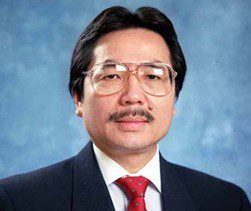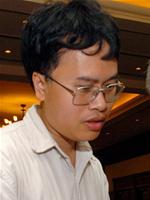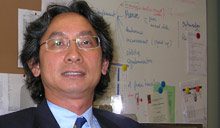Introducing a summary of the success of three notable Vietnamese expatriate scientists in the United States and Australia, who have brought honor to Vietnam in the field of modern physics.
During the 1970s and 1980s, Vietnamese people took pride in the international achievements of Vietnamese physicists such as Nguyễn Văn Hiệu, Đào Vọng Đức, Nguyễn Xuân Hãn, and Trịnh Xuân Thuận. Today, the younger generations continue to carry on the legacy of their predecessors, writing the next glorious chapter in this history.
Vo Dinh Tuan – 30 Patents and Dozens of Awards
 |
|
Dr. Vo Dinh Tuan. (Photo: ND) |
At the age of 17, after graduating from high school in Vietnam, Vo Dinh Tuan went to Switzerland for further studies and obtained a bachelor’s degree in physics in 1971. Four years later, he successfully defended his Ph.D. thesis in physical chemistry at the Swiss Federal Institute of Technology (ETH) in Zurich. In 1975, he settled in the United States, and two years later, he became a postdoctoral researcher at Oak Ridge National Laboratory (ORNL).
With his continuous successes in scientific research, since 2003, he has been the director of the Quantum Light Center at ORNL and later served as the director of the Fitzpatrick Institute for Quantum Light in the United States. Dr. Tuan is a pioneer in the field of quantum light, establishing foundational work for the Fitzpatrick Institute in areas such as: Biological Quantum Light, Nanotechnology, Optical Materials, and Quantum Information Technology.
Dr. Tuan has also researched improvements in new technologies, such as optical nano-sensors capable of detecting molecular changes at the cellular level; ultra-small biophotonic circuitry technology that makes chemical experiments easier and less expensive; and quantum optics that enhance the security of transmitting personal medical data.
After nearly 30 years in scientific work, Dr. Tuan has authored over 30 patents and inventions widely applied in environmental, biological, and medical fields. He has published more than 330 articles in journals and periodicals and is the author of six books on scientific topics, in addition to being a lecturer at several universities.
Dr. Tuan has received five Research and Development (R&D) awards in 1981, 1987, 1992, 1994, and 1996. In 1988, he was honored with a gold medal from the Application Spectroscopy Society; in 1989, he won the Languedoc-Rousillon Prize from France; in 1992, he was awarded the International Hall of Fame by the American Inventors Club. He has also received the Technology Transfer Award from the Federal Laboratory Consortium twice (in 1986 and 1995).
In 1996, he was named Inventor of the Year by the American Inventors Club and the Tennessee Inventors Association; in 1997, he received the U.S. Department of Energy’s Technology and Environmental Research Award, and the following year, he won the Technology Commercialization Award…
Reflecting on his career journey, Dr. Tuan shared: “From my time studying in Vietnam, my parents helped me recognize the value of education and ignited my passion for science. Back then, my father often said: ‘Material wealth can be lost at any moment; only knowledge will accompany you throughout your life.’ Therefore, after graduating from high school, I seriously considered the beginning of my career. After completing my research in physics, I was determined to successfully defend my Ph.D. thesis, and my scientific journey has opened up from there…”
Dam Thanh Son – New Discoveries in Physics
Dam Thanh Son was born in 1969 in Hanoi. As a talented mathematics student at Hanoi University, at just 15 years old, he was selected for the national team to compete in the International Mathematical Olympiad in Prague, where he won a gold medal with a perfect score of 42/42.
 |
| Young Physicist – Dam Thanh Son (Photo: ND) |
Dam Thanh Son was chosen to study physics at the prestigious Lomonosov Moscow State University in Russia. After completing his Ph.D. dissertation in Russia at the age of 24, he went on to intern at the University of Washington (USA) before spending two years at the Massachusetts Institute of Technology (MIT), and then successfully obtaining a position as a lecturer at Columbia University in 1999.
In early 2005, Dam Thanh Son and his collaborators P.K. Kovtun (University of California, USA) and A.O. Starinets (Perimeter Institute for Theoretical Physics, Canada) published a groundbreaking paper on the model of liquid black holes in 10-dimensional spacetime in the prestigious journal Physical Review Letters. This new discovery immediately garnered significant attention in the academic community.
Major scientific publications like New Scientist (April 2005) and Physics Today (May 2005) featured articles on this work, a theoretical discovery that, if experimentally confirmed, would represent a new universal law of physics.
The journal Physics World invited Dam Thanh Son, a leading physicist, to write an article titled “Liquid Universe Meets String Theory” to explain this new issue.
The New Scientist published an article by Jenny Hogan titled “Exotic Blackholes Spawn New Universal Law.” The author used the term “exotic” because these are not necessarily black holes with properties observed in physical reality, but rather a “black hole” modeled by Dam Thanh Son’s team using string theory in 10-dimensional spacetime to describe a strongly interacting liquid, specifically a quark-gluon liquid existing in the familiar four-dimensional spacetime. Thus, the “black hole” here is merely a mathematical tool used in calculations. Using string theory in 10-dimensional spacetime, Dam Thanh Son’s team calculated that the matter produced by the Relativistic Heavy Ion Collider (RHIC) is indeed an almost ideal liquid with a ratio of viscosity to entropy density as a constant related to fundamental constants in the quantum world, such as Planck’s constant and Boltzmann’s constant.
The results achieved by Dam Thanh Son in the United States demonstrate that the Vietnamese intellect is capable not only of grasping the most intricate and complex issues of modern science but can also reach fundamental, unique discoveries, provided they work in a progressive scientific environment.
Dam Thanh Son confided: “No matter where I am, I strive to unleash my creativity in the field of science I pursue, and my heart will always turn towards Vietnam, where my parents, relatives, friends, and teachers who guided me during my years in mathematics school are.”
Kieu Tien Dung – The Father of Quantum Computing
Kieu Tien Dung was born in 1961 in Saigon. In 1980, he left Vietnam to settle and study in Australia. In 1984, after graduating with honors in mathematics and physics from the University of Queensland, Kieu Tien Dung received a scholarship to pursue his Ph.D. at the University of Edinburgh in the UK. After completing his dissertation in 1988, he became a professor at both the University of Edinburgh and the University of Oxford. In 1991, he returned to become a professor at the University of Melbourne while also collaborating with the most prestigious universities in the United States, such as Princeton University, Columbia University, and MIT.
In a recent research paper applying quantum mechanics principles to computational science submitted to the Los Alamos National Laboratory, Professor Kieu Tien Dung made a significant conclusion: “We refute the Turing-Church thesis by demonstrating that there exist problems that are unsolvable according to Turing’s principles, but can be solved by performing clearly defined quantum mechanical processes.” In other words, Professor Dung discovered that problems currently deemed unsolvable by conventional computers can actually be resolved using quantum computers—machines based on quantum encoding principles.
According to Newsfactor, Professor Kieu Tien Dung’s work can strike two targets with one shot: David Hilbert’s tenth problem and Alan Turing’s SCTM. He has made a discovery that could propel mathematics and computer science of the previous century beyond their own limits: problems once considered “unsolvable” or “non-computable” might be solved by utilizing the mysterious properties of quantum mechanics. This work is currently attracting attention from many scientists worldwide as it presents the principles for a future quantum computer capable of solving problems that are classified as unsolvable or non-computable by conventional computers.
 |
| Professor Kieu Tien Dung at Swinburne University (Photo: ND) |
The New Scientist magazine, a pioneer in introducing new ideas in science, commented that this is a bold attack on the very limits of mathematics, allowing us to reclaim treasures that we thought would forever lie beyond our reach. It may take several decades for such strange quantum computers to emerge, but even now, Professor Kieu Tien Dung is recognized as a daring individual willing to confront the most significant and challenging issues in computational science!
Dr. Richard Gomez, a professor at George Mason University in the United States and a highly respected expert in computer science today, stated: “I have read the works of Professor Kieu Tien Dung and found them to be entirely consistent with the discoveries of other researchers in the fields of quantum computing and quantum physics. There is no doubt that there is now a widespread acceptance that information has physical characteristics. Simply put, Professor Kieu Tien Dung has managed to exploit the laws of quantum physics to achieve results that cannot be attained in the realm of classical physics.”
If the theories of these scientists are confirmed by experiments in the near future, they could represent achievements on par with the most timeless works of computational science in the 21st century. This evaluation will be tested quickly or slowly depending on the pace of development of quantum computing technology.
Professor Kieu Tien Dung was originally a first-year student at the University of Ho Chi Minh City. His passion for research has successively brought him to high scientific levels around the world. He has become a talent for Australia, but his heart always aches for his homeland, Vietnam. He frequently returns to Vietnam to participate in seminars and contribute ideas for developing human training strategies.
He shared: “Vietnamese people have made numerous contributions across various fields to the countries where they reside. I take pride in the successes of Vietnamese individuals everywhere. This is a vast treasure of intellectual resources, all sharing the common heritage of Vietnamese blood, which needs to be harnessed directly or indirectly for the prosperity of the country. In my opinion, Vietnam has the potential to rise up and catch up with other countries in a relatively short time, as we have a stable education system, almost no illiteracy, and a young, eager-to-learn population. However, this issue must be addressed not only through education, skills, and expertise but also depends on many other factors such as national policies, management capabilities, investment laws, and so on…”
In conclusion, I would like to borrow the idea from Professor Kieu Tien Dung’s reflections: all Vietnamese scientists working domestically or abroad constitute a vast treasure of intellectual resources, all sharing the common heritage of Vietnamese blood, which needs to be harnessed directly or indirectly for the prosperity of the nation.
Dr. Ngo Tu Thanh (Postal and Telecommunications Institute of Technology)


















































